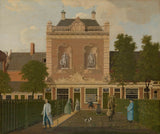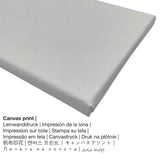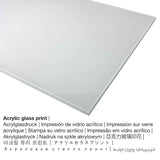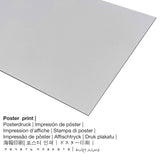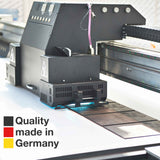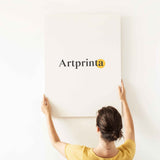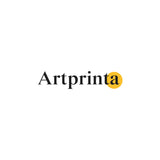Hendrik Keun, 1772 - Ogige na Ụlọ nchịkwa nke 524 Keizersgracht na Amsterdam - ọmarịcha akwụkwọ nka.
Ụtụ gụnyere. Mbupu gbakọrọ na ndenye ọpụpụ.
Ozi nkowa mgbakwunye from Rijksmuseum (© - site na Rijksmuseum - Rijksmuseum)
Nicolaas Doekscheer, who lived at 524 Keizersgracht, built a grand, Rococo coach house on the Kerkstraat, which adjoined the back of his garden. He is here depicted conversing with the gardener, while his wife speaks to a maidservant. The two young men are Doekscheer’s nephews and heirs. The painting is still in its original Rococo frame.
Ozi ndabere nka
| Aha eserese: | "The Garden and Coach House of 524 Keizersgracht in Amsterdam" |
| Nhazi nke ihe nka: | sere |
| Category: | nka ochie |
| oge: | 18th narị afọ |
| Afọ okike: | 1772 |
| Ogologo afọ nka nka: | ihe dị ka afọ 240 |
| Ụlọ ihe ngosi nka: | Rijksmuseum |
| Ebe ngosi nka: | Amsterdam, Netherlands |
| website: | www.rijksmuseum.nl |
| Ikikere nke ihe osise: | ngalaba ọha |
| Site n'aka: | Rijksmuseum |
Nchịkọta ihe nkiri
| Aha onye nka: | Hendrik Keun |
| Aha nka ndị ọzọ: | Kuen, Kuhn, Henry Keun, Kuhn Hendrik, Kuen Hendrik, Hend. Keun, Hendrik Keun, Keuin, Keun, Keun Hendrik, Keuin Hendrik, H. Keun |
| okike onye nka: | nwoke |
| Nationality: | Dutch |
| Ọrụ nke onye na-ese ihe: | onye na-ese ihe |
| Country: | mba netherland |
| nhazi ọkwa: | nna ukwu ochie |
| Nwụrụ anwụ: | 50 afọ |
| Afọ ọmụmụ: | 1738 |
| Nwụrụ n'afọ: | 1788 |
Nkọwa ihe ahaziri ahazi
| Nkewa edemede: | nka nka |
| Mmeputakwa: | dijitalụ mmeputakwa |
| Usoro mmepụta: | Mbipụta UV ozugbo (mbipụta dijitalụ) |
| Nlụpụta: | emere na Germany |
| Stockdị ngwaahịa: | mmepụta ihe na-achọ |
| Eji ngwaahịa emebere: | ime ụlọ, nka mgbidi |
| Ndozi onyonyo a: | nhazi odida obodo |
| Ụdị anya: | ogologo: obosara - 1.2: 1 |
| Ihe: | ogologo bụ 20% ogologo karịa obosara |
| Akụrụngwa dị: | akwụkwọ mmado (akwụkwọ kwaaji), mbipụta ọla (aluminium dibond), mbipụta kanvas, mbipụta iko acrylic (nwere ezigbo mkpuchi iko) |
| Mbipụta kanvas (akwa akwa na etiti ihe ndọtị) dị iche iche: | 60x50cm - 24x20", 120x100cm - 47x39" |
| Acrylic glass print (nwere ezigbo mkpuchi iko) nhọrọ: | 60x50cm - 24x20", 120x100cm - 47x39" |
| Nhọrọ nke mbipụta akwụkwọ mmado (akwụkwọ kwaaji): | 60x50cm - 24x20", 120x100cm - 47x39" |
| Nhọrọ aluminom dibond (ihe aluminom) nhọrọ: | 60x50cm - 24x20", 120x100cm - 47x39" |
| Igwe onyonyo: | agunyeghi |
Họrọ ngwa ngwaahịa ịchọrọ ịnwe
The product dropdown menu ofers you the opportunity to pick a material and a size of your choice. You can choose among the following product customization options:
- Mbipụta kanvas: The UV printed canvas material applied on a wood frame. It makes a special impression of three dimensionality. Further, a canvas creates a attractive and comfy atmosphere. The advantage of canvas prints is that they are relatively low in weight, meaning that it is quite simple to hang up your Canvas print without the help of extra wall-mounts. A canvas print is suitable for any type of wall.
- Mpempe akwụkwọ ederede (akwa akwa akwa): A poster print is a printed canvas paper with a slightly rough surface texture. The poster print is best suited for putting the art replica with the help of a personal frame. Please keep in mind, that depending on the absolute size of the poster print we add a white margin between 2-6 cm around the print motif in order to facilitate the framing with your custom frame.
- Mbipụta iko acrylic (nke nwere ezigbo mkpuchi iko n'elu): A glossy print on acrylic glass, often labelled as a print on plexiglass, changes an original into beautiful home décor. Further, the acrylic fine art print is a distinct alternative to canvas or dibond fine art prints. Your work of art will be made with state-of-the-art UV direct printing technology. With an acrylic glass art print sharp contrasts and smaller painting details will be exposed due to the subtle gradation.
- Aluminom ihe eji eme ihe: Aluminium Dibond prints are prints on metal with an outstanding effect of depth. The Direct Print on Aluminum Dibond is your perfect start to the sophisticated world of fine art replicas made with aluminum. For your Direct Print On Aluminum Dibond, we print the artpiece onto the surface of the white-primed aluminum material. The white and bright parts of the artwork shimmer with a silky gloss but without any glare. Colors are bright and luminous, the details of the print appear crisp. The print on aluminium is the most popular entry-level product and is a stylish way to display art, because it draws focus on the replica of the artwork.
Nkọwa nke ngwaahịa a
Ihe karịrị 240 afọ masterpiece e sere site na Dutch artist Hendrik Keun in 1772. N'ịga n'ihu, ihe osise ahụ dị n'ime Rijksmuseum's nchịkọta dijitalụ na Amsterdam, Netherlands. a nka ochie ngalaba ọha Ibé nka na-gụnyere na nkwanye ùgwù nke Rijksmuseum.Ebe E Si Nweta nke ihe osise:. Ọzọkwa, itinye n'usoro mmepụta dijitalụ dị na odida obodo format ma nwee akụkụ nke 1.2: 1, nke pụtara na ogologo bụ 20% ogologo karịa obosara.
Ederede iwu dị mkpa: We try everything to depict our art products as accurate as possible and to display them visually on the various product detail pages. At the same time, the tone of the printed materials, as well as the print result may differ somehwat from the representation on the screen. Depending on the settings of your screen and the quality of the surface, color pigments may not be printed one hundret percent realistically. Because our art reproductions are processed and printed manually, there might as well be minor differences in the motif's exact position and the size.
© Nwebiisinka - ikike ọgụgụ isi nke - Artprinta (www.artprinta.com)

